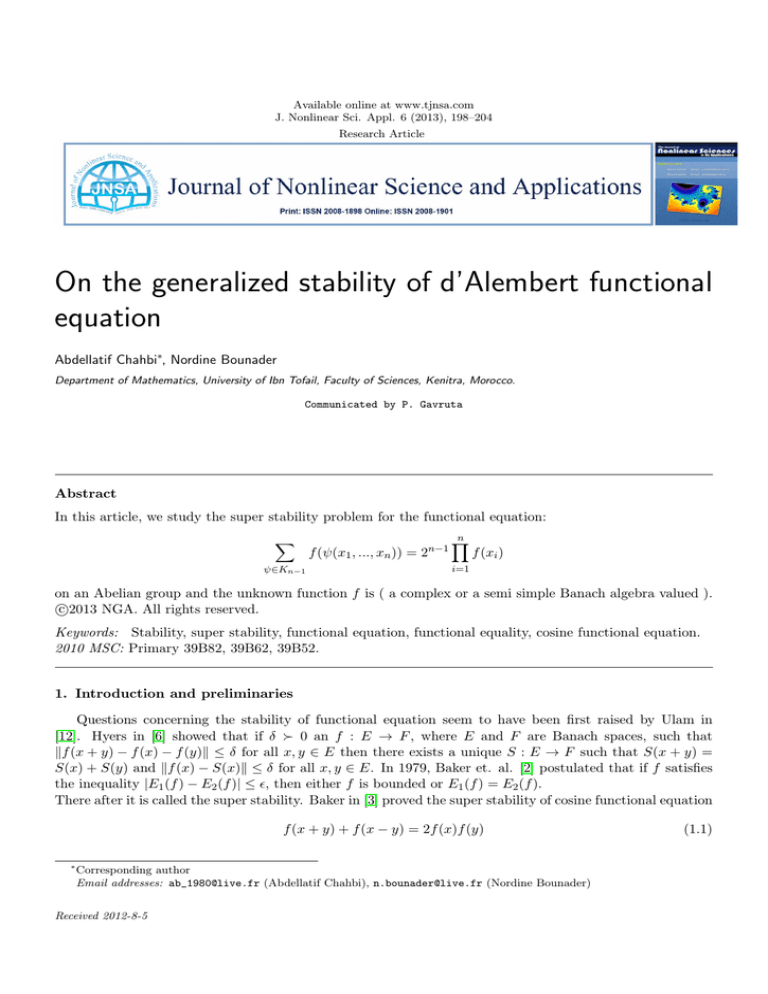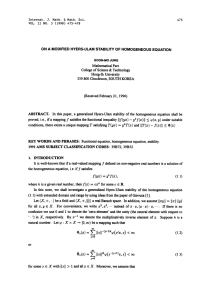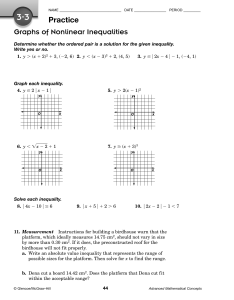
Available online at www.tjnsa.com
J. Nonlinear Sci. Appl. 6 (2013), 198–204
Research Article
On the generalized stability of d’Alembert functional
equation
Abdellatif Chahbi∗, Nordine Bounader
Department of Mathematics, University of Ibn Tofail, Faculty of Sciences, Kenitra, Morocco.
Communicated by P. Gavruta
Abstract
In this article, we study the super stability problem for the functional equation:
X
ψ∈Kn−1
f (ψ(x1 , ..., xn )) = 2n−1
n
Y
f (xi )
i=1
on an Abelian group and the unknown function f is ( a complex or a semi simple Banach algebra valued ).
c
2013
NGA. All rights reserved.
Keywords: Stability, super stability, functional equation, functional equality, cosine functional equation.
2010 MSC: Primary 39B82, 39B62, 39B52.
1. Introduction and preliminaries
Questions concerning the stability of functional equation seem to have been first raised by Ulam in
[12]. Hyers in [6] showed that if δ 0 an f : E → F , where E and F are Banach spaces, such that
kf (x + y) − f (x) − f (y)k ≤ δ for all x, y ∈ E then there exists a unique S : E → F such that S(x + y) =
S(x) + S(y) and kf (x) − S(x)k ≤ δ for all x, y ∈ E. In 1979, Baker et. al. [2] postulated that if f satisfies
the inequality |E1 (f ) − E2 (f )| ≤ , then either f is bounded or E1 (f ) = E2 (f ).
There after it is called the super stability. Baker in [3] proved the super stability of cosine functional equation
f (x + y) + f (x − y) = 2f (x)f (y)
∗
Corresponding author
Email addresses: ab_1980@live.fr (Abdellatif Chahbi), n.bounader@live.fr (Nordine Bounader)
Received 2012-8-5
(1.1)
A. Chahbi, N. Bounader, J. Nonlinear Sci. Appl. 6 (2013), 198–204
199
Which is also called the d’Alembert functional equation. The stability of the generalized cosine functional
equation has been investigated in many papers ([4, 5, 7, 8, 9, 10, 11]). In 2002, Badora and Ger [1] proved the
super stability of d’Alembert functional equation concerning complex-valued mappings, as in the following
theorem.
Theorem 1.1. Let (G, +) be an Abelien group. Let f : G → C and ϕ : G → [0, ∞) satisfy the inequality
kf (x + y) + f (x − y) − 2f (x)f (y)k ≤ ϕ(x) or ϕ(y) ∀x, y ∈ G
Then, either f is bounded or f satisfies Eq. (1.1).
In this paper, let (G, +) be an Abelian group, C the field of complex numbers, and Kn−1 = K n−1 with
K = {+I, −I}. We consider the functional equation :
X
f (ψ(x1 , ..., xn )) = 2
n−1
n
Y
f (xi )
(1.2)
i=1
ψ∈Kn−1
and the difference operator Df : Gn → C as
Df (x1 , ..., xn ) =
X
f (ψ(x1 , ..., xn )) − 2n−1
with ψ(x1 , ..., xn ) = x1 +
f (xi )
i=1
ψ∈Kn−1
n
X
n
Y
αi (xi ) and αi ∈ K.
i=2
The object of Theorem 1.1 is to show that the equation can be viewed as a generalization of the cosine
functional equation Eq.(1.1). The aim of this paper is to investigate the improved super stability for
functional equation Eq.(1.2) as follows |Df (x1 , ..., xn )| ≤ ϕ(xi ) for i = 2...n.
Moreover, we extend all super stability result for Eq.(1.2) to the super stability on the commutative semi
simple Banach algebra.
2. Super Stability of Eq.(1.2)
In this section we will investigate the supers stability of the functional equation Eq.(1.2). The functional
equation Eq. (1.2) is connected with the d’Alembert functional equation Eq.(1.1) as follows:
Lemma 2.1. A complex valued function f on an Abelian group satisfies the functional equation:
X
f (ψ(x1 , ..., xn )) = 2n−1
ψ∈2n−1
n
Y
f (xi )
i=1
for all x1 , ..., xn ∈ G and f (0) ≥ 0 if and only f satisfies the d’Alembert functional equation:
f (x + y) + f (x − y) = 2f (x)f (y)∀ x, y ∈ G
Proof. If f is a solution of Eq. (1.2), then by substituting x1 , ..., xn by 0 we have:
f (0)n = f (0)
since f (0) ≥ 0 so f (0) = 0 or 1. If f (0) = 0 then f = 0, and if f (0) = 1 then by taking x3 = ... = xn = 0
we get
2n−2 (f (x1 + x2 ) + f (x1 − x2 )) = 2n−1 f (x1 )f (x2 )
so that
f (x1 + x2 ) + f (x1 − x2 ) = 2f (x1 )f (x2 ).
A. Chahbi, N. Bounader, J. Nonlinear Sci. Appl. 6 (2013), 198–204
200
Conversely, let f solution of Eq. (1.1), the assertion is true for n = 2. Assuming that the assertion is true
for n − 1, hence we have
X
X
f (ψ(x1 + xn , x2 , ..., xn )) + f (ψ(x1 − xn , x2 , ..., xn ))
f (ψ(x1 , ..., xn )) =
ψ∈Kn−1
ψ∈Kn−1
= 2n−2 f (x1 + xn ).
n−1
Y
f (xi ) + 2n−2 f (x1 − xn ).
i=2
= 2n−1
n
Y
n−1
Y
f (xi )
i=2
f (xi ).
i=1
Lemma 2.2. Let (G, +) be an Abelian group, f : G → C and ψ : G → R+ satisfy the inequality:
|Df (x1 , ..., xn )| ≤ ϕ(xn )
(2.1)
for all x1 , ..., xn ∈ G. If there exist a sequence yk such that
|f (yk )| → +∞
for k → +∞ then
|f (2i yk )| → +∞
for i ∈ {0, ..., n − 3}.
Proof. We use induction on i, the assertion of Lemma (2.2) is true for i = 0. Assuming that is true for i,
hence by taking x1 = x2 = 2i yk and x3 = ... = xn = 0 in the inequality (2.1). We have
|2n−2 f (2i+1 yk ) + 2n−2 f (0) − 2n−1 (f (2i yk ))2 f (0)n−2 | ≤ ϕ(0)
so that
|f (2i+1 yk )| → +∞.
Theorem 2.3. Let (G, +) be an Abelian group, f : G → C and ϕ : G → R+ satisfies the inequality (2.1)
then either f is bounded or satisfies the functional equation Eq.(1.2) for all x1 , ..., xn ∈ G and n ≥ 3.
Proof. Let f be unbounded, then by Lemma (2.2) we can choose a sequence {yk } in G such that |f (2i yk | → ∞
as k → ∞, for i = 0, ..., n − 3. Firstly we use induction on n to prove that:
X
f (ψ(2n−3 yk , ..., 2yk , yk , yk , xn ))
(2.2)
ψ∈Kn−1
n−2
= f (2
n−2
yk + xn ) + f (2
yk − x n ) + 2
2n−3
X−1
f ((2n−2 − 2i)yk + xn )
i=1
2n−3 −1
+ 2
X
i=1
f ((2n−2 − 2i)yk − xn ) + f (xn ) + f (−xn )
A. Chahbi, N. Bounader, J. Nonlinear Sci. Appl. 6 (2013), 198–204
201
The assertion (2.4) is true for n = 3. Assuming that is true for n − 1, hence we have:
X
X
f (ψ(2n−4 yk , ..., 2yk , yk , yk , xn ) + 2n−3 yk )
f (ψ(2n−3 yk , ..., 2yk , yk , yk , xn )) =
ψ∈Kn−2
ψ∈Kn−1
X
+
f (ψ(−2n−4 yk , 2n−5 yk , ..., 2yk , yk , yk , xn ) − 2n−3 yk )
ψ∈Kn−2
X
=
f (ψ(2n−4 yk , ..., 2yk , yk , yk , xn ) + 2n−3 yk )
ψ∈Kn−2
X
+
f (ψ(−2n−4 yk , ..., −2yk , −yk , −yk , xn ) + 2n−3 yk )
ψ∈Kn−2
= f ((2n−3 yk + xn ) + 2n−3 yk ) + f ((2n−3 yk − xn ) + 2n−3 yk )
+ 2
2n−4
X−1
f ((2n−3 − 2i)yk + xn + 2n−3 yk )
i=1
2n−4 −1
+ 2
X
i=1
n−3
+ f (2
f ((2n−3 − 2i)yk − xn + 2n−3 yk )
yk + xn ) + f (2n−3 yk − xn )
+ f (−2n−3 yk + xn + 2n−3 yk ) + f ((−2n−3 yk − xn + 2n−3 yk )
+ 2
2n−4
X−1
f (−(2n−3 − 2i)yk + xn + 2n−3 yk )
i=1
2n−4 −1
+ 2
X
i=1
n−3
+ f (2
f (−(2n−3 − 2i)yk − xn + 2n−3 yk )
yk + xn ) + f (2n−3 yk − xn ).
= f (2n−2 yk + xn ) + f (2n−2 yk − xn )
+ 2
2n−4
X−1
f ((2n−2 − 2i)yk + xn )
i=1
2n−4 −1
+ 2
X
f ((2n−2 − 2i)yk − xn )
i=1
+ 2
2n−4
X−1
f (2iyk + xn ) + f (2iyk − xn )
i=1
n−3
+ 2(f (2
yk + xn ) + f (2n−3 yk − xn ))
+ f (xn ) + f (−xn ).
And using the fact that:
2
2n−4
X−1
f (2iyk + xn ) + f (2iyk − xn ) = 2
2n−3
X−1
i=2n−4 +1
i=1
+ 2
2n−3
X−1
i=2n−4 +1
the induction proof is completed.
f ((2n−2 − 2i)yk + xn )
f ((2n−2 − 2i)yk − xn )
A. Chahbi, N. Bounader, J. Nonlinear Sci. Appl. 6 (2013), 198–204
202
Now putting
A(xn ) = f (2n−2 yk + xn ) + f (2n−2 yk − xn )
+ 2
2n−3
X−1
f ((2n−2 − 2i)yk + xn ) + f ((2n−2 − 2i)yk − xn ).
i=1
And taking x1 = 2n−3 yk ...xn−3 = 2yk and xn−2 = xn−1 = yk in (2.1) we obtain
A(x ) + f (x ) + f (−x )
ϕ(xn )
n
n
n
−
f
(x
)
n ≤ n−3
n−3
Y
Y
2n−1 f (y )
f (2i yk )
f (2i yk )
2n−1 f (yk )
k
i=0
i=0
then
lim
k→+∞
A(xn )
= f (xn ), xn ∈ G
n−3
Y
2n−1 f (yk )
f (2i yk )
(2.3)
i=0
Note that, the result is invariant under the inversion of xn , we deduce that f is even.
In the next we will show that f satisfies the functional equation Eq.(1.2), putting
Bψ = f (ψ(2n−2 yk + x1 , x2 , ..., xn )) + f (ψ(2n−2 yk − x1 , x2 , ..., xn ))
+ 2
2n−3
X−1
f (ψ((2n−2 − 2i)yk + x1 , x2 , ..., xn ))
i=1
+ 2
2n−3
X−1
f (ψ((2n−2 − 2i)yk − x1 , x2 , ..., xn ))
i=1
|
X
ψ∈Kn−1
n−2
f (ψ((2
− 2i)yk + x1 , x2 , ..., xn )) − 2
n−1
n−2
f ((2
− 2i)yk + x1 )
n
Y
f (xi )| ≤ ϕ(xn ).
(2.4)
i=2
And letting: x1 = (2n−2 − 2i)yk − x1 for i = 0, ..., 2n−3 − 1 in (2.1) we have
n
Y
X
n−2
n−1
n−2
f (ψ((2
− 2i)yk − x1 , x2 , ..., xn )) − 2
f ((2
− 2i)yk − x1 )
f (xi ) ≤ ϕ(xn )
ψ∈Kn−1
i=2
For all x1 , ..., xn ∈ G:
Combining (2.4) and (2.5), and using the evenness of f , we see that
X
n
Y
n−1
Bψ − 2
f (xi )A(x1 ) ≤ (2n−1 − 2)ϕ(xn )
ψ∈Kn−1
i=2
for all x1 , ..., xn ∈ G. Now, we fix ψj ∈ Kn−1 for j = 1, 2, 3, ..., 2n−1 , then we get
(2.5)
(2.6)
A. Chahbi, N. Bounader, J. Nonlinear Sci. Appl. 6 (2013), 198–204
Bψj
203
= f (2n−2 yk + ψj (x1 , x2 , ..., xn )) + f (2n−2 yk − ψj (x1 , x2 , ..., xn ))
+ 2
2n−3
X−1
f ((2n−2 − 2i)yk + ψj (x1 , x2 , ..., xn ))
i=1
+ 2
2n−3
X−1
f ((2n−2 − 2i)yk − ψj (x1 , x2 , ..., xn ))
i=1
Using the fact (2.3) of f , we see that
Bψj
lim
k→+∞
2n−1 f (yk )
n−3
Y
= f (ψj (x1 , x2 , ..., xn ))
i
f (2 yk )
i=0
Therefore, dividing each side of the inequality (2.6) by
2
n−1
f (yk )
n−3
Y
f (2i yk )
i=0
and taking the limit as k → +∞, we get
X
f (ψ(x1 , x2 , ..., xn )) = 2
n−1
n
Y
f (xi )
i=1
ψ∈Kn−1
Corollary 2.4. Let δ be positive real number and let f : G → C be a function satisfying the inequality
|Df (x1 , ..., xn )| ≤ δ for all x1 , ..., xn ∈ G and n ≥ 3, then either f is bounded or f satisfies the functional
equation:
n
X
Y
f (ψ(x1 , x2 , ..., xn )) = 2n−1
f (xi )
i=1
ψ∈Kn−1
3. Extension to Banach algebra
All results in section 2 can be extended to the super stability on the commutative semi simple Banach
algebra. In this section, let (G, +) be an Abelian group, and (E, k.k) be a commutative semi simple algebra.
Theorem 3.1. Assume that f : G → E and ϕ : G → R+ satisfy the inequality
kDf (x1 , ..., xn )k ≤ ϕ(xn )
(3.1)
for all x1 , ..., xn ∈ G and n ≥ 3. If the superposition x∗ ◦ f is unbounded for each linear multiplicative
functional x∗ ∈ E ∗ , then f satisfies the functional equation Eq.(1.2).
Proof. Assume that (3.1) holds and fixe arbitrarily linear multiplicative functional x∗ ∈ E. As is well known
we have kx∗ k = 1, whence, for every x1 , ..., xn ∈ G, we have
ϕ(xn ) ≥ kDf (x1 , ..., xn )k
= Supky∗ k=1 |D(y ∗ ◦ f )(x1 , ..., xn )|
≥ |D(x∗ ◦ f )(x1 , ..., xn )|
A. Chahbi, N. Bounader, J. Nonlinear Sci. Appl. 6 (2013), 198–204
204
which states that the superposition x∗ ◦ f yield a solution of the inequality (2.1) of section 2 in the Theorem
(2.3). Since by assumption the superposition x∗ ◦ f is unbounded, an appeal to Theorem (2.3) shows that
x∗ ◦ f solve functional equation Eq.(1.2). In other words, bearing the linear multi pliability of x∗ , for all
x1 , ..., xn ∈ G the difference Df (x1 , ..., xn ) falls into the kernel of x∗ .
Therefore, in view of the unrestricted choice of x∗ , we infer that
Df (x1 , ..., xn ) ∈ {kerx∗ ; x∗ is multiplicative of E ∗ }
for all x1 , ..., xn ∈ G. Since the algebra E has been assumed to be semi simple, the last term of the above
formula coincides with the singleton {0}, that is
Df (x1 , ..., xn ) = 0 ∀x1 , ..., xn ∈ G
as claimed. This completes the proof.
Corollary 3.2. Let δ be positive real number and let f : G → E be a function satisfying the inequality:
kDf (x1 , ..., xn )k ≤ δ for all x1 , ..., xn ∈ G and n ≥ 3. If the superposition x∗ ◦ f is unbounded for each linear
multiplicative functional x∗ ∈ E ∗ , then f satisfies the functional equation
X
ψ∈Kn−1
f (ψ(x1 , x2 , ..., xn )) = 2n−1
n
Y
f (xi ).
i=1
Similarly, one can prove that if the difference Df (x1 , ..., xn ) is bounded by ϕ(x2 ) or ϕ(x3 ), ..., or ϕ(xn−1 )
one obtains the same result as in the Theorem (2.3).
References
[1] R. Badora, R. Ger, On some trigonometric functional inequalities, Functional Equations- Results and Advances,
12 (2002), 3-15. 1
[2] J. Baker, J. Lawrence and F. Zororzitto, The stability of the equation f(x+y) = f(x)f(y), Proc. Amer. Math. Soc.,
74 (1979), 242-246. 1
[3] J. A. Baker, The stability of the cosine equation, Proc. Amer. Math. Soc., 80 (1980), 411-416. 1
[4] E. Elqorachie, M. Akkouchi, On Hyers-Ulam stability of the generalized Cauchy and Wilson equations, Publ.
Math. Debrecen, 66 (2005), 283-301. 1
[5] P. Gavruta, On the stability of some functional equation, In: Stability of Mappings of Hyers- Ulam Type, Hardronic
Press, Palm Harbor, FL, U.S.A. (1994), 93–98. 1
[6] D. H. Hyers, On the stability of the linear functional equatinon, Proc. Natl. Acad. Sci. USA., 27 (1941), 93–101.
1
[7] S.-M. Jung,Hyers-Ulam-Rassias Stability of Functional Equations in Nonlinear Analysis, Series Springer Optimization and Its Applications 48, Springer, 2011. (Chapter 12). 1
[8] G. H. Kim, The stability of the dAlembert and Jensen type functional equations, J. Math. Anal Appl., 325 (2007),
237–248. 1
[9] H. M. Kim, G.H. Kim and M. H. Han, Superstability of approximate dAlembert, Journal of Inequalities and
Applications 2011. 1
[10] P. Nakmahschalasint, The stability of a cosine functional equation. KMITL Sci J. 1 (2007), 49-53. 1
[11] A. Redouani, E. Elqorachi, B. Bouikhalene, Hyers-Ulam stability of the generalized trigonometric formulas, JIPAM, 7 (2006) Article 74. 1
[12] S. M. Ulam, Problems in Modern Mathematics, Chap.VI, Science editions, Wiley, New York, 1964. 1








